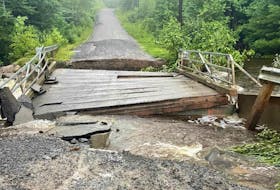SYDNEY, N.S. — The waters off Cape Breton are a summer feeding grounds for great white sharks, says a biologist who will be part of an expedition that’s coming here to tag some of the giant predators next week.
Bob Hueter is the chief scientific adviser for Ocearch, a Florida-based shark research group that catches great whites, collects samples and affixes satellite tags to their dorsal fins.

The team then names them and gives them Twitter accounts so the public can follow their travels on social media and Ocearch's shark tracker website.
And that’s where Ocearch will focus its efforts next week when its team of fishermen and scientists will search for great whites along Scatarie Island and Hay Island from Monday until Thursday. The Post is scheduled to accompany the expedition on Tuesday. One of the sharks they tagged, a 4.8-metre-long male named Hilton, became something of a local celebrity last September when he spent considerable time near Main-a-Dieu, Mira Gut, Port Morien and Donkin on the island’s eastern coast.

“Our master fishermen on the trip have studied the charts and read about Scatarie and Hay islands, and they think with the seal population there and the topography of the place, this might be a very good place to try,” said Hueter, who compared the two islands off Main-a-Dieu with West Ironbound Island south of Lunenburg, where Ocearch encountered a total of 10 great whites last fall, catching seven and tagging six, due to size restrictions on its Fisheries and Oceans-issued permit.
Five of those six sharks tagged in Nova Scotia — Hal, Luna, Jefferson, Jane and Cabot —returned to the province this summer after venturing as far away as the Gulf of Mexico. Brunswick, a 2.7-metre great white shark swam around Cape Breton in August on his way to Iles-de-la-Madeleine northeast of Prince Edward Island.
While Hilton’s satellite tracker hasn’t pinged his location since mid-March, Hueter believes he’s likely here.

“I’m guessing he’s probably back but several things may have happened. The most likely is his tag is compromised in some way. Sometimes we’ll get these weak signals from the shark’s tag that will not give us a location and won’t show up on the tracker. So we’re looking into that to see if we’re getting anything indicative of his tag still transmitting, albeit very weakly. Sometimes of course these animals just go deep and they stay deep but for that length of time and an animal that was a really good pinger before, that’s unlikely. The last possibility — we never want to jump to that conclusion and it’s the saddest — that Hilton was caught by a fisherman somewhere and that he has been removed. Sometimes we see evidence of that when our tag all of a sudden moves in a straight line in the ocean to a port in Portugal or Spain. We haven’t seen that in this case and we certainly hope that wasn’t the case with Hilton. I’m guessing it’s something to do with his tag and these things happen from time to time.”
Hueter said there’s no doubt that a population of great whites comes here to feed and possibly even breed.

“When we first came there last year, we were sort of operating under a hypothesis based on the fact very large males and females were coming together, that this might be a place where they’re mating,” he said. “We were excited to come up to possibly discover one of the mating grounds for the white sharks, which is one of the things that’s not known yet for the Atlantic and really for anywhere in their range across the world. We did not see any evidence of that last year — that’s not to say it doesn’t exist because we only basically worked on seven animals, but it’s still out there as a possibility.
"There’s no question though that it’s a major feeding area. There’s abundant food — there’s seals, there’s a variety of fish life that they feed on there — the waters are healthy there and the sharks are taking advantage of it. And they’re not just stopping there, they’re going as far north as the southern coast of Newfoundland and even sometimes out to the open sea beyond that. Right now it’s definitely a summer foraging area — no question about that. Whether it serves in some other capacity as a place for reproduction, only time will tell.”
Once Ocearch leaves Cape Breton, the team will work its way south back to West Ironbound Island before wrapping up its expedition Oct. 4.
RELATED:








